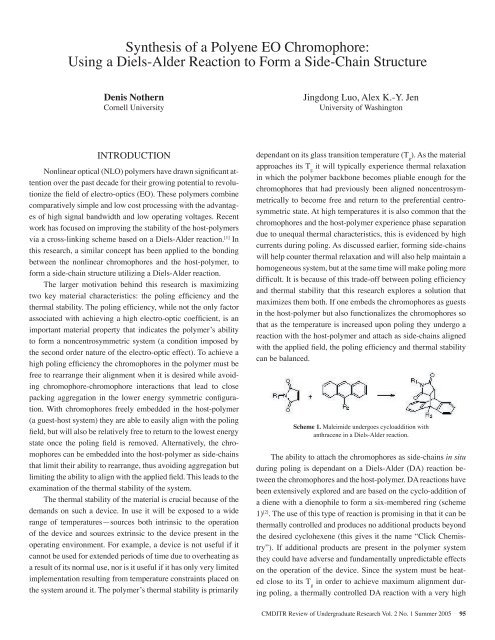Student Project Abstracts 2005 - Pluto - University of Washington
Student Project Abstracts 2005 - Pluto - University of Washington
Student Project Abstracts 2005 - Pluto - University of Washington
Create successful ePaper yourself
Turn your PDF publications into a flip-book with our unique Google optimized e-Paper software.
Synthesis <strong>of</strong> a Polyene EO Chromophore:Using a Diels-Alder Reaction to Form a Side-Chain StructureDenis NothernCornell <strong>University</strong>Jingdong Luo, Alex K.-Y. Jen<strong>University</strong> <strong>of</strong> <strong>Washington</strong>INTRODUCTIONNonlinear optical (NLO) polymers have drawn significant attentionover the past decade for their growing potential to revolutionizethe field <strong>of</strong> electro-optics (EO). These polymers combinecomparatively simple and low cost processing with the advantages<strong>of</strong> high signal bandwidth and low operating voltages. Recentwork has focused on improving the stability <strong>of</strong> the host-polymersvia a cross-linking scheme based on a Diels-Alder reaction. [1] Inthis research, a similar concept has been applied to the bondingbetween the nonlinear chromophores and the host-polymer, t<strong>of</strong>orm a side-chain structure utilizing a Diels-Alder reaction.The larger motivation behind this research is maximizingtwo key material characteristics: the poling efficiency and thethermal stability. The poling efficiency, while not the only factorassociated with achieving a high electro-optic coefficient, is animportant material property that indicates the polymer’s abilityto form a noncentrosymmetric system (a condition imposed bythe second order nature <strong>of</strong> the electro-optic effect). To achieve ahigh poling efficiency the chromophores in the polymer must befree to rearrange their alignment when it is desired while avoidingchromophore-chromophore interactions that lead to closepacking aggregation in the lower energy symmetric configuration.With chromophores freely embedded in the host-polymer(a guest-host system) they are able to easily align with the polingfield, but will also be relatively free to return to the lowest energystate once the poling field is removed. Alternatively, the chromophorescan be embedded into the host-polymer as side-chainsthat limit their ability to rearrange, thus avoiding aggregation butlimiting the ability to align with the applied field. This leads to theexamination <strong>of</strong> the thermal stability <strong>of</strong> the system.The thermal stability <strong>of</strong> the material is crucial because <strong>of</strong> thedemands on such a device. In use it will be exposed to a widerange <strong>of</strong> temperatures—sources both intrinsic to the operation<strong>of</strong> the device and sources extrinsic to the device present in theoperating environment. For example, a device is not useful if itcannot be used for extended periods <strong>of</strong> time due to overheating asa result <strong>of</strong> its normal use, nor is it useful if it has only very limitedimplementation resulting from temperature constraints placed onthe system around it. The polymer’s thermal stability is primarilydependant on its glass transition temperature (T g). As the materialapproaches its T git will typically experience thermal relaxationin which the polymer backbone becomes pliable enough for thechromophores that had previously been aligned noncentrosymmetricallyto become free and return to the preferential centrosymmetricstate. At high temperatures it is also common that thechromophores and the host-polymer experience phase separationdue to unequal thermal characteristics, this is evidenced by highcurrents during poling. As discussed earlier, forming side-chainswill help counter thermal relaxation and will also help maintain ahomogeneous system, but at the same time will make poling moredifficult. It is because <strong>of</strong> this trade-<strong>of</strong>f between poling efficiencyand thermal stability that this research explores a solution thatmaximizes them both. If one embeds the chromophores as guestsin the host-polymer but also functionalizes the chromophores sothat as the temperature is increased upon poling they undergo areaction with the host-polymer and attach as side-chains alignedwith the applied field, the poling efficiency and thermal stabilitycan be balanced.Scheme 1. Maleimide undergoes cycloaddition withanthracene in a Diels-Alder reaction.The ability to attach the chromophores as side-chains in situduring poling is dependant on a Diels-Alder (DA) reaction betweenthe chromophores and the host-polymer. DA reactions havebeen extensively explored and are based on the cyclo-addition <strong>of</strong>a diene with a dienophile to form a six-membered ring (scheme1) [2] . The use <strong>of</strong> this type <strong>of</strong> reaction is promising in that it can bethermally controlled and produces no additional products beyondthe desired cyclohexene (this gives it the name “Click Chemistry”).If additional products are present in the polymer systemthey could have adverse and fundamentally unpredictable effectson the operation <strong>of</strong> the device. Since the system must be heatedclose to its T gin order to achieve maximum alignment duringpoling, a thermally controlled DA reaction with a very highCMDITR Review <strong>of</strong> Undergraduate Research Vol. 2 No. 1 Summer <strong>2005</strong> 95




